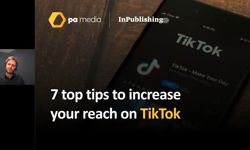
‘Data is the new oil’ has been the mantra in publishing circles in recent years, but as Catrin Griffiths, editor of The Lawyer and PPA Business Editor of the Year, has learned, data on its own is not enough.
Last autumn, Griffiths gave a speech to the PPA Independent Publisher Conference in which she admitted that The Lawyer’s main data product, Lawyer Market Intelligence, launched in 2016, was a bit of a damp squib until she and her team realised data must be backed up by analysis and insight.
“LMI was important for us because it got us into the game of data, but it also made us realise that data on its own is not enough,” says Griffiths. “When we originally launched, everyone was talking about ‘data is the new oil’, that was what our readers wanted so they could make decisions based on data. All of this is fantastic in theory, but in practice, it doesn’t work, because the only people who want to read data are people with data jobs. When we went to market with LMI, it met minimum levels of subscription demand, but it didn’t change things in the way we thought it would and we realised that people who use data don’t always see the stories. Our job is to say what we think the stories are.”
Expanding data portfolio
The Lawyer has now added the new Litigation Tracker to its data portfolio, which allows its readers to see what deals have been done by which law firms dating back to 2015.
“It’s a historic look back and we do it on the quarter, saying this is the chambers with the most appearances in Chancery, this is the chambers which is the busiest in the Employment Appeals Tribunal. All of that information is available in public, but no one has put it together,” explains Griffiths.
This information would count for little on its own, but Griffiths ensures her journalists never stop learning on the job. She says: “We spend a lot of time in training new journalists. Even if they have come out with an MA in journalism, that’s just our starting point. Everything they write goes through draft after draft, particularly the long form stuff. It’s a constant learning process and getting my sign-offs is deliberately made quite hard.”
It’s a constant learning process and getting my sign-offs is deliberately made quite hard.
Story selection
The new litigation tracker has paved the way for proprietary news stories and content such as the popular ‘Top 20 cases of the year’.
“That’s enormous because everyone knows what case they’re doing, but they don’t know what everyone else is doing. They want to see if there’s a trend. This year, for example, there were three Brexit related cases. For the last few years, there have been quite a lot of Libor rigging cases. People want to know who is acting for who. It is a qualitative assessment. We don’t rank them one to 20, but we say these are the 20 most interesting cases. That’s become a real focal point,” says Griffiths. She adds that a lot of The Lawyer’s reporting is predictive, using a combination of data and insight to see what’s coming around the corner.
Me Too dominated the legal news agenda in 2018, with law firms being brought under scrutiny for the way in which they treat their own staff, as well as the controversial use of Non-Disclosure Agreements.
“It was so extensive we even had a widget on it. We surveyed our audience: Me Too within the legal industry. What that showed was the lack of trust between your average line lawyer and the HR departments. That sort of thing is not nice reading for law firms, but it helps them to identify what the problem is and their communication issues with their staff. We didn’t do that in the spirit of sticking two fingers up at law firms, we didn’t know what the answers were going to reveal,” says Griffiths.
The senior editorial team on The Lawyer devotes much time to discussing how they can move stories on and find new angles. To be competitive in today’s information market place requires seeking out original news stories and producing excellent long form articles, not simply rewriting press releases, Griffiths insists.
“News meetings are not just about pitching stories; it’s a proper discussion about why this works. Sometimes that can be an hour and I think it’s really important to take the time. Everyone should know more at the end of the day than they did to start with, including me,” says Griffiths.
She believes it is important to “understand the absolute nuances of organisational culture of law firms, all of which are very different. A Freshfields is very different from a Mishcon de Reya. It’s sort of intangible and it’s our job to express that intangibility. You not only cover law as a profession and its own issues around pay and salaries and new arrivals and globalisation, but you also have to understand about what an M&A lawyer does, a litigation lawyer, a private equity lawyer, a real estate lawyer. It’s not a narrow specialism at all.”
95% of The Lawyer’s content is behind a paywall, with a tier of individual and corporate subscription packages.
Introducing a paywall
Griffiths has been at the helm of The Lawyer since 2000 and it is still housed in the same office block just behind Oxford Street, although it has changed floors. At the time, it was a classic controlled circulation B2B magazine with a news front page and a huge recruitment section at the back. In 2011, the magazine changed to a picture front cover and became more features led, then in 2016, it went behind a paywall.
Griffiths remembers: “In June of that year, there was the Brexit vote. We were worried about traffic after going behind a paywall, but that Friday, we were getting instant reaction in terms of the legal thinking behind it and people were just desperate for quality commentary, trying to make sense of this extraordinary thing that’s happening. I remember thinking at the time that this huge spike in traffic meant that we had a potentially engaged audience.”
Now, with the exception of some free content for student subscribers, 95% of The Lawyer’s content is behind a paywall, with a tier of individual and corporate subscription packages. The audience is senior people in management teams at private practice law firms, general counsel and senior lawyers within companies.
“Our audience are scarily clever. They are demanding readers. They can see through a simplistic analysis really quickly. Therefore, you want to give them content to come back, the digital habit that everyone talks about which is the Holy Grail. They’re not going to come back if it’s a quick headline you can digest in ten seconds. Stickability is about investing some time,” says Griffiths.
Diversity is an area The Lawyer has been pushing on since long before other organisations woke up to it. “We’ve been talking about diversity for years and years, not just gender, but also ethnicity and LGBT. People don’t want to talk about class and that’s a massive thing for law. We’ve been talking about that a long time and challenging firms to do better in terms of who they field as spokespeople, visible representatives for their firms.”
Everyone should know more at the end of the day than they did to start with, including me.
Desktop vs Mobile
While The Lawyer is mobile-optimised and mobile usage is growing among its audience, those working in the legal sector are not massive mobile adopters for work yet, and its readers still tend to browse industry news and features while sitting at a desk behind a computer.
“They are reading it in the morning in the office and at lunchtime; it is on the whole a wonderful distraction from a lot of documents they have to deal with. As with everything else, mobile use is massively increasing but has it overtaken desktop use? No,” says Griffiths.
She would like to increase The Lawyer’s international presence, but the title has already benefited from London being at the centre of the legal world together with New York.
“London at the moment, alongside New York, is the most important law centre in the world. London arguably more interesting because it has the most openings. It also has a major court system. English law is really, really important. If you’re going to be doing a major deal, you are as likely to use English law as anything else.”
The Lawyer’s international editor is a native Mandarin speaker, which has been useful in covering Asian markets, but the title does not use freelancers, which can create a barrier when it comes to expanding globally.
The brand has recently invested in a new tech reporter, Cristiano Dalla Bonna. Technology is vitally important to the legal profession, as to other industries, but Griffiths admits readers were just not that excited about technology pieces. Recruiting someone to concentrate on this area has helped to change that perception.
“He wrote a great piece about law firms collaborating with universities on a whole bunch of tech innovation projects. They’re real slow burn pieces. They sit on the site and they just get shared slowly and surely, until at the end of the year, you realise you’ve actually got quite a large audience for these pieces.”
Griffiths’s key learning from the digital revolution of the last few years is: “Invest in journalism. I will say that until my blood runs dry. Journalism is not content, it can and should challenge. Sometimes you’re going to get into rows with people who say I’m not going to subscribe any more. So be it.”
She adds: “Data is evidence, it’s not the story itself. The people who run magazines and brands are at home with spreadsheets and they understand data. It’s harder to spreadsheet what quality is. I think, collectively, editors should get together and work out a way of expressing what that is. Usually it is about something that no one else has thought of that’s new and original and fresh.”
Our audience are scarily clever. They are demanding readers. They can see through a simplistic analysis really quickly.












